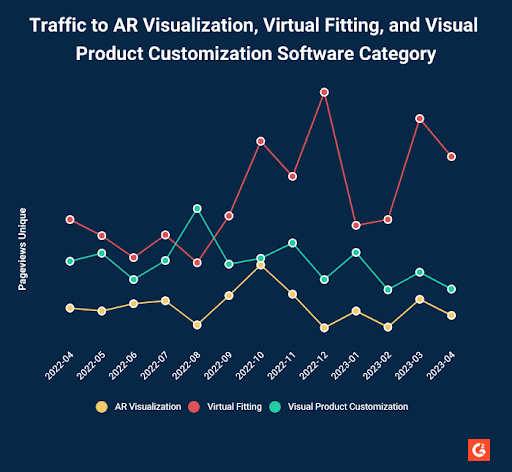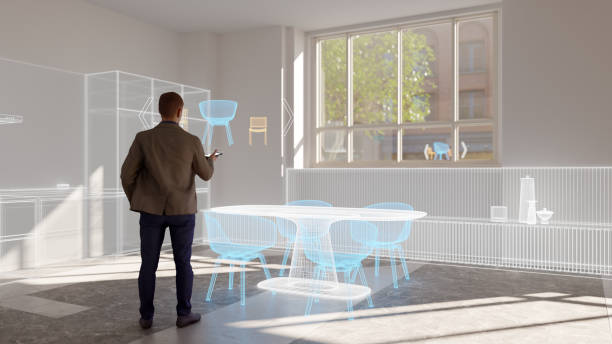While augmented reality (AR) isn’t new, it isn’t old in retail.
Two years ago, the pandemic introduced retailers to retail dynamics they had never witnessed before. Apart from the invaluable lessons in managing the supply chain and pacing up with unprecedented consumer expectations, it also taught the importance of investing in the right technology.
One such technology that is revolutionizing retail space across the globe is the use of AR technology in business. It helps bring high-level personalization in digital and physical retail stores for shoppers.
Let’s look at how AR is used in the retail industry and how tools in G2’s Retail Software categories use this technology to meet this ever-growing demand.
Mobilizing immersive experiences through augmented reality (AR)
In my blog, we discussed how consumers actively seek a personalized experience when visiting an online retail website and are no longer invested in traditional retailing. But, as consumer expectations grow, demands have shifted from a customized to a more immersive shopping experience.
Though e-commerce personalization software enhances personalization on e-commerce websites, consumers seek more virtual experiences associated with products in the real physical world. AR plays a pivotal role in making this happen.
According to data from Vertebrae, retailers using AR have seen a 19% spike in sales, and their conversion rate has increased by 90% versus those who don’t.
AR offers exciting opportunities to enhance customer engagement, improve shopping experiences, and bridge the gap between physical and online shopping. Let’s try to understand the application and use cases of AR in retail and how software can help achieve this goal.
Want to learn more about Visual Product Customization Software? Explore Visual Product Customization products.
From virtual try-on to interactive product exploration: harnessing AR in retail
The versatility of AR technology allows virtual objects and information to be overlaid in the real world, providing a unique and interactive experience for shoppers. It plays a significant role in connecting retail's physical and online worlds.
Here are some ways in which augmented reality is used in retail:
Virtual try-on: AR enables customers to virtually try on products such as clothing, accessories, and cosmetics without physically wearing them. Whether apparel, accessories, or cosmetics, customers can try it on virtually, in real time, using a smartphone, tablet, or AR-enabled mirror.
This technology enhances the shopping experience, helps customers make more informed decisions, and reduces the need for physical trial rooms.
Product visualization: AR enables customers to visualize products in their environment. For example, using a smartphone or tablet, customers can place virtual furniture, home decor, or other items in their living spaces to see how they would look in real.
This feature is handy for online retailers where customers cannot physically interact with products.
Interactive in-store experiences: Retailers can create interactive experiences in their physical stores using AR. For instance, they can set up AR kiosks or displays that provide additional product information, offer virtual demonstrations, or even gamify the shopping experience.
This technology helps to engage customers and create brand awareness and an immersive shopping experience.
Guided in-store navigation: AR can assist customers in navigating large retail spaces such as malls or department stores. With their smartphone or smart glasses, shoppers can access AR-powered maps and directions to easily find specific products or stores within the premises.
This feature helps to improve customer convenience, reduces time spent searching for items, and enhances the overall shopping experience.
Virtual showrooms and fittings: AR enables retailers to create virtual showrooms or fitting rooms where customers can browse and try on products. This is particularly useful for businesses with limited physical space and a wide range of products.
This allows customers to view and interact with the product, promoting engagement and increasing the likelihood of a purchase.
Use cases of AR in retail
It is quite evident that many brands have already started using AR in their space. Consumers also actively demand to see and experience such technology while they shop. Google confirmed that 34% of shoppers are interested in using AR while shopping. Let’s examine a few use cases of AR by different brands.
- IKEA Place App allows users to drag and drop a selected product to fully visualize the product in the room and how it looks.
- Nike Fit size recommendation feature uses AR to provide hyper-accurate shoe size recommendation by scanning the user’s feet with a smartphone camera.
- NYX Professional Makeup’s AR feature allows users to virtual-try on beauty and make-up products before they buy.
- Warby Parker’s and Lenskart’s virtual try-on feature allows users to scan their faces and recommends the ideal pairs of glasses.
- ASOS trials ‘See My Fit’ offers customers a simulated view of a product on models of different sizes and body types.
G2’s AR categories for your retail business
G2 has many augmented reality software categories for businesses of different types. If someone is looking mainly for their retail and e-commerce business, Augmented Reality (AR) Visualization Software, Virtual Fitting Software, and in some cases, Visual Product Customization Software can help.
While AR visualization software can help businesses add capabilities like virtual try-on, product visualization, etc., into a brand’s e-commerce website, virtual fitting software can help provide customers with accurate fit recommendations based on body measurements.
Businesses can also use visual product customization software to customize products visually with 3D modeling and rendering techniques. Some visual product customization software extends its capabilities to AR technology, offering features like virtual try-on, virtual fitting, etc. Others can easily integrate with AR visualization software to superimpose virtual representations of the customized product onto their real-world environment.

Traffic to these categories has been inconsistent, with many peaks and valleys in the past 12 months. However, the category traffic for Virtual Fitting Software has grown by 34%, which signals interest from companies trying to find out AR-based virtual fitting solutions is picking up.
Most of the traffic comes from retail and e-commerce companies looking for such solutions for their apparel division online. The peak traffic for all three categories is highest between August to December 2022, as this is the time retail and e-commerce companies prepare for their upcoming holiday season sale. It will be interesting to see the trends for the rest of the year 2023-2024 and how companies will invest in such AR software.
Final thoughts
The interest of retail and e-commerce companies in AR is growing with the curiosity of customers to explore such features while shopping. While it guarantees a reduction in the rate of return and increases engagement, businesses are yet to proactively add such tech capabilities. We still see room for more active engagement of retail businesses in the AR categories and ensure the success of companies using them.
Edited by Shanti S Nair

Subhransu Sahu
Subhransu is a Senior Research Analyst at G2 concentrating on applications technology. Prior to joining G2, Subhransu has spent 2 years working in various domains of marketing like sales and market research. Having worked as a market research analyst at a renowned data analytics and consulting company based in the UK, he holds expertise in deriving market insights from consumer data, preparing insight reports, and client servicing in the consumer and technology domain. He has a deep inclination towards tech innovation and spends most of his time browsing through tech blogs and articles, wiki pages, and popular tech channels on youtube.
